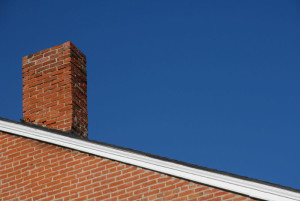When experiencing burning issues, many of us look first at fireplace and chimney components such as the damper, flue, or chimney cap. However, your drafting or venting issues may be caused by an unusual cause – chimney height.
Chimney height is extremely important and can have a major impact on how your fireplace drafts and draws in fresh air. Because of this, many chimney drafting and venting issues can be tied back to chimney height or the height of surrounding buildings or trees.

Does my chimney need to be a specific height?
While there is no specific or standardized height for chimneys, the height your chimney needs to be will be dependent on the height of your house, roof, and surrounding buildings or trees. According to National Fire Protection Association Standard 211 and the International Residential Code, chimneys must be at least 3 feet higher than the high sides of the roof it exits. Likewise, chimneys must also be at least 2 feet higher than any dormers, roofs, or trees within 10 feet of the chimney.Chimney height requirements are not purely aesthetic or made to make your roofline look better; how tall a chimney is can have a major impact on the efficiency and safety of your fireplace. If your chimney fails to meet the required standards, you will experience venting and drafting issues that cannot be remedied with other repairs.
What happens if my chimney is too short?
My chimney just started venting poorly – could it still be height related?
While it is unlikely that a sudden-onset drafting issue is caused by your chimney height, it is not impossible. If you have several tall trees in your yard, it is important that trees within 10 feet of the chimney are always at least two feet shorter than the height of the chimney. This height difference prevents poor venting from occurring.Likewise, sudden onset drafting issues can occur if you build a new addition or if a nearby neighbor builds a structure taller than your existing chimney. To prevent this, it is important to work with a builder who understands the height requirements of chimneys and can create plans to either extend the chimney or make any additions shorter than the existing structure.
If you are experiencing chimney venting or drafting issues that do not seem to be helped by any repairs or changes to burning patterns, your chimney may be too short. Contact New Buck Chimney Services today to schedule a chimney inspection to find out if chimney height is affecting your burning performance, venting, or drafting.

